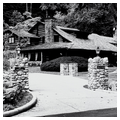To expand the city's park system, Huntington's Board of Park Commissioners purchased separate tracts of land a mile west and a mile east of Ritter Park in the 1920s. The western tract was named Kiwanis Park, the eastern Rotary, after the two fraternal organizations that helped develop them. Impressive houses soon lined the boulevards that connected the new parks with Ritter Park. Between Ritter Park and Kiwanis Park, North Boulevard follows the meanderings of Four Pole Creek on one side, while South Boulevard, renamed Whitaker Boulevard west of 5th Street, is on the opposite side of the stream. The two boulevards join at 5th Street West and continue westward as Memorial Boulevard, passing the Memorial Arch. East of Ritter Park, Washington Boulevard leads in an equally meandering fashion to Rotary Park.
The colorful yellow brick bungalow at 240 North Boulevard sports a bright red tile roof. Its equally colorful neighbor at 210 is a yellow-stuccoed Mediterranean villa with a number of projections, all covered with a variegated tile roof. Yellowwood, the expansive, lowlying house at 401 Whitaker, was begun as a log hunting lodge in 1911. A stone addition was built three years later. A cobblestone chimney and a rugged slate roof that sweeps down over the porch add to the intentional rusticity of this “log cabin revival” house, perfectly suited to its woody, West Virginia setting.



















